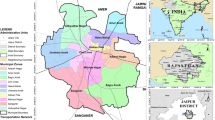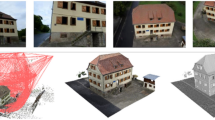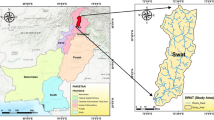Abstract
Traditional Euclidean geometry-based Geographical Information System (GIS) is not multidimensional unification with weak ability to object expression and analysis of high dimensions. Geometric algebra (GA) can connect different geometric and algebra systems, and provide rigorous and elegant foundation for expression, modeling and analysis in GIS. This paper proposes the implementation methods for system construction and key components of multidimension-unified GIS. Based on such properties as multidimension-unified and coordinate-free of GA, data models, data indexes, and data analysis algorithms for multidimensional vector data, raster and vector field data are developed. This study indicates that GA provides a new mathematical tool for the development of GIS characterized as multidimension-unified expression and computation. For the development of geographical analysis methods, it can represent multidimensional spatio-temporal changes conveniently.
Similar content being viewed by others
References
X. Li, J.Q. He, X.Q Liu, Intelligent GIS for solving high-dimensional site selection problems using ant colony optimization techniques. International Journal of Geographical Information Science 23(4) (2009), 399–416.
R. Devillers, Y. Bedard, R. Jeansoulin, Multidimensional management of geospatial data quality information for its dynamic use within GIS. Photogrammetric Engineering and Remote Sensing 71(2) (2005), 205–215.
G. Gerhard, P. Lutz, How to achieve consistency for 3D city models. Geoinformatica 15(1) (2011), 137–165.
S.W. Wang, Y. Liu, TeraGrid GIScience Gateway: Bridging cyberinfrastructure and GIScience. International Journal of Geographical Information Science 23(5) (2009), 631–656.
D. Karssenberg, D.J. KE, Dynamic environmental modelling in GIS: 1.Modelling in three spatial dimensions. International Journal of Geographical Information Science 19 (5) (2005), 559–579.
G. Gröger, L. Plüer, Topology of surfaces modelling bridges and tunnels in 3D-GIS. Computers. Environment and Urban Systems 35(3) (2011), 208–216.
M. Breunig, S. Zlatanova, 3D geo-database research: Retrospective and future directions. Computers & Geosciences 37(7) (2011), 791–803.
M. Worboys, M. Duckham, Monitoring qualitative spatiotemporal change for geosensor networks. International Journal of Geographical Information Science 20 (10) (2006), 1087–1108.
J. McIntosh, M. Yuan, A framework to enhance semantic flexibility for analysis of distributed phenomena. International Journal of Geographic Information Science 19(10) (2005), 999–1018.
M. Pilout, K. Tempfli, M. Molenaar, A tetrahedron - based 3D vector data model for geoinformation. Advanced Geographic Data Modelling (40) (1994), 129–140.
D.Y. Shen, K. Takara, Y. Tachikawa, 3D simulation of soft geo-objects. International Journal of Geographical Information Science 20(3) (2006), 261–271.
L. Wu, Topological relations embodied in a generalized tri-prism (GTP) model for a 3D geoscience modeling system. Computers & Geosciences 30(4) (2004), 405–418.
K.F. Liu, W.Z. Shi, Computing the fuzzy topological relations of spatial objects based on induced fuzzy topology. International Journal of Geographical Information Science 20(8) (2006), 857–883.
J. Martinez-Llario, J.H. Weber-Jahnke, E. Coll, Improving dissolve spatial operations in a simple feature model. Advances in Engineering Software 40 (3) (2009), 170–175.
M.J. Mineter, A software framework to create vector-topology in parallel GIS operations. International Journal of Geographical Information Science 17 (3) (2003), 203–222.
S. Loch-Dehbi, L. Plüer, Automatic reasoning for geometric constraints in 3D city models with uncertain observations. ISPRS Journal of Photogrammetry and Remote Sensing 66(2) (2011), 177–187.
R.F. Gholam, U.F. Andrew, S.M. Mohammad, et al., An ontological structure for semantic interoperability of GIS and environmental modeling. International Journal of Applied Earth Observation and Geoinformation 10(3) (2008), 342–357.
A.H. Monahan, J.C. Fyfe, M.H. Ambaum, et al., Empirical orthogonal functions: The medium is the message. Journal of Climate 22(24) (2009), 6501–6514.
A. Hannachi, S. Unkel, N.T. Trendafilov, et al., independent component analysis of climate data: a new look at eof rotation. Journal of Climate 22(11) (2009), 2797–2812.
L. Dorst, D. Fontijne, S. Mann, Geometric algebra for computer science: an object-oriented approach to geometry. The Morgan Kaufmann Series in Computer Graphics. Morgan Kaufmann Publishers, San Francisco, 2007.
Li H.B.: Invariant algebras and geometric reasoning. World Scientific Publishing, Hongkong (2008)
A. Lasenby, Recent applications of conformal geometric algebra. In H.Li, P.J.Olver and G.Sommer (eds.). IWMM 2004, LNCS 3519 Springer-Verlag. 2005.
E. Bayro-Corrochano, Geometric computing for wavelet transforms. robot vision, control, learning control and action, Springer Verlag, London. 2010.
J. Lasenby, W.J. Fitzgerald, A.N. Lasenby, et al., New geometric methods for computer vision: An application to structure and motion estimation. International Journal of Computer Vision, 26(3) (1998), 191–213.
D. Hestenes, G. Sobcyk, Clifford algebra to geometric calculus: a unified language for mathematics and physics. Dordrecht: D. Reidel Publishing, 1984.
C. Perwass, Geometric algebra with applications in engineering. Springer- Verlag, Heidelberg, 2009.
D. Hestenes, New foundations for classical mechanics. Kluwer, New York, 2002.
M. Pavšič, Clifford space as a generalization of spacetime: Prospects for QFT of point particles and strings. Foundations of Physics 35(9) (2005), 1617–1642.
D. Hestenes, Curvature calculations with spacetime algebra. International Journal of Theoretical Physics 25(6) (1986), 581–588.
C. Doran, A. Lasenby, Geometric algebra for physicists. Cambridge University Press, New York, 2003.
L.W. Yuan, Z.Y. Yu, S.F. Chen, et al., CAUSTA: Clifford algebra based unified spatio-Temporal analysis. Transactions in GIS, 14(s1) (2010), 59–83.
C. Gold, M.A. Mostafavi, Towards the global GIS. ISPRS Journal of Photogrammetry and Remote Sensing, 55(3) (2000), 150–163.
R.O.C. Tse, C.M. Gold, TIN meets CAD—extending the TIN concept in GIS. Future Generation Computer Systems, 20(7) (2004), 1171–1184.
M.P. Kwan, J.Y. Lee, Emergency response after 9/11: the potential of real-time 3D GIS for quick emergency response in micro-spatial environments. Computers, Environment and Urban Systems, 29(2) (2005), 93–113.
Y.C. Lee, M. Molenaar, Theme issue on dynamic and multidimensional GIS. ISPRS Journal of Photogrammetry and Remote Sensing 55(3) (2000), 137–138.
H. Demirel, A dynamic multidimensional conceptual data model for transportation applications. ISPRS Journal of Photogrammetry and Remote Sensing 58(5–6) (2004), 301–314.
J. Mennis, Multidimensional map algebra: Design and implementation of a spatio-temporal GIS processing language. Transactions in GIS 14(1) (2010), 1–21.
E. Bayro-Corrochano, J. Rivera-Rovelo. The use of geometric algebra for 3D modeling and registration of medical data. Journal of Mathematical Imaging and Vision 24(1) (2009), 34:48–60
D. Hestenes, New tools for computational geometry and rejuvenation of screw theory. In Bayro-Corrochano, E.J. and Scheuermann, G. (eds.), Geometric Algebra Computing: In Engineering and Computer Science. Springer, Berlin, (2010), 3–35.
E. Bayro-Corrochano, L. Reyes-Lozano, J. Zamora-Esquivel, Conformal geometric algebra for robotic vision. Journal of Mathematical Imaging and Vision 24(1) (2006), 24, 55–81.
E. Bayro-Corrochano, G. Sommer, Object modelling and collision avoidance using Clifford algebra. Lecture Notes in Computer Science 970 (1995), 699–704.
E. Hitzer, Euclidean geometric objects in the Clifford geometric algebra of Origin, 3-Space, Infinity. Bulletin of the Belgian Mathematical Society-Simon Stevin 11(5) (2005), 653–662.
L.W. Yuan, Z.Y. Yu, W. Luo, et al., A 3D GIS spatial data model based on conformal geometric algebra. SCI China Ser D-Earth SCI 54(1) (2011), 101–112.
Z.Y. Yu, Multidimensional unified GIS data nodel based on GA. Thesis of Nanjing Normal University for Doctoral Degree, 2011.
A. Jadczyk, Quantum fractals on n-spheres. Clifford algebra approach. Advances in Applied Clifford Algebras 17(2) (2007), 201–240.
E. Hitzer, B. Mawardi, Clifford Fourier transform on multivector fields and uncertainty principles for dimensions n=2 (mod 4) and n=3 (mod 4). Advances in Applied Clifford Algebras 18(3–4) (2008), 715–736.
E. Bayro-Corrochano, N. Arana-Daniel, Clifford support vector macines for classification, regression and recurrence. IEEE Transactions on Neural Networks 21(1) (2010), 1731–1746.
K. Rieger, K. Schlacher, J. Holl, On the observability of discrete-time dynamic systems - A geometric approach. Automatica 44(8) (2008), 2057–2062.
H. Eckhard, Angles between subspaces computed in Clifford algebra. AIP Conference Proceedings of International Conference of Numerical Analysis and Applied Mathematics (2010), 1476–1479.
B. Jancewicz, Multivectors and Clifford algebra in electrodynamics. World Scientific, 1988.
W. Luo, Characteristics analysis and motion expression of temporal-spatial field data based on geometric algebra. Thesis of Nanjing Normal University for Master Degree, 2011.
J. Y. Zhang, GIS network analysis based on Clifford algebra. Thesis of Nanjing Normal University for Master Degree, 2010.
L. Yi, Multi-dimensional unified algorithm and application of voronoi based on conformal geometric algebra. Thesis of Nanjing Normal University for Master Degree, 2011.
D. Hildenbrand, J. Pitt, A. Koch, Gaalop-high performance parallel computing based on conformal geometric algebra. In E. Bayro-Corrochano and G. Scheuermann (eds.), Geometric Algebra Computing for Engineering and Computer Science. Springer Verlag, London, 2010.
D. Fontijne, Gaigen 2: a geometric algebra implementation generator. In: 5th International Conference on Generative Programming and Component Engineering, Budapest (2006), 141–150.
A. Gentile, S. Segreto, F. Sorbello, CliffoSor: A parallel embedded architecture for geometric algebra and computer graphics. Seventh International Workshop on Computer Architecture for Machine Perception (CAMP 2005). Palermo, Italy (2005), 90–95.
L.W. Yuan, G. N. Lü, W. Luo, et al., Geometric algebra method for multidimensionally-unified GIS computation. Chinese Science Bulletin 57(7) (2012), 802–811.
Z.Y. Yu, L.W. Yuan, W. Luo, et al., Design and implementation of GIS temporal spatial analysis system based on Clifford algebra. Geomatics and Information Science of Wuhan University 36(12) (2011), 1397–1401.
Z.Y. Yu, L. W. Yuan, W. Luo, et al., Boundary restricted non-overlapping sphere tree for unified multidimensional solid object index. Journal of Software (in press).
L. Yi, L. W. Yuan, Z. Y. Yu, et al., Clifford algebra-based voronoi algoritm. Geography and Geo-information Science 27(5) (2011), 37–41.
Author information
Authors and Affiliations
Corresponding author
Rights and permissions
About this article
Cite this article
Yuan, L., Yu, Z., Luo, W. et al. Geometric Algebra for Multidimension-Unified Geographical Information System. Adv. Appl. Clifford Algebras 23, 497–518 (2013). https://doi.org/10.1007/s00006-012-0375-z
Received:
Accepted:
Published:
Issue Date:
DOI: https://doi.org/10.1007/s00006-012-0375-z




